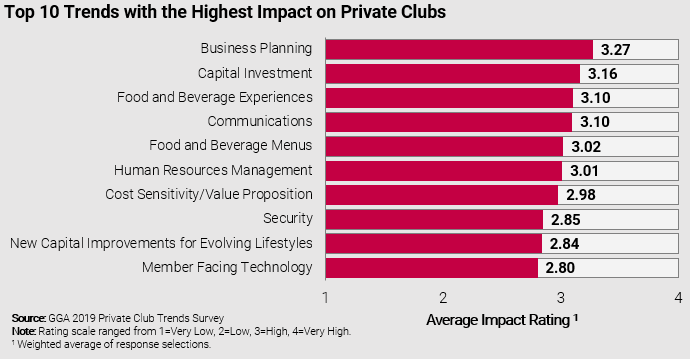Board members are an important source of experience and knowledge. But when making strategic decisions on the future direction of the club, that expertise can easily be hampered by a lack of access to valuable data and actionable information.
GGA’s Bennett DeLozier explains how to connect your board with the critical insights they need from outside the boardroom.
Scenario: you’re a manager, it’s sunny, you’re in a board meeting, fluorescent lights buzz overhead. The group is brainstorming capital improvement projects ahead of next season. The topics of budget, capital reserves, assessments, competitor offerings, and attracting new members swirl around the room.
Someone claims that what members “really want” are new amenities, another counters that new amenity supporters are mostly younger members in restricted categories, a third comments on the price of dues for this group. Opinions begin to diverge on membership pricing, someone mentions member satisfaction, people start using the word ‘should’, and a healthy, productive conversation turns to conjecture.
In this situation, a common reference point can bring everyone back on task. You’re confident you probably have data points on all of these topics somewhere in your office or in your inbox. You’re scrolling, scrolling. Before long, the meeting adjourns with decisions on hold, and you leave with a list of research tasks and staff projects to tackle in advance of the next one.
Board Members Need Information
While this scenario may be an overdramatization, it’s not terribly uncommon. This is what happens when intelligent, capable people face important decisions without actionable information. It deters strategic thinking and is taxing for the manager and staff.
Board members are usually smart, business-oriented people and they expect to have empirical discussions just as they have done in their own line of work. Their job is to strategize, and a strategy is only as good as the information which informs it.
The most effective club managers gather, consolidate and deliver a war chest of information to the boardroom in order to facilitate better, easier, and quicker decisions.
The Right Kind of Data
A word of caution: not all data is good data and managers are wise to beware the data ‘dump’. So, what does the right kind of data look like?
- Data that is current. In a perfect world, the provision is real-time data and predictive analytics. Data should be updated as frequently as possible and be on-hand for timely, relevant insight before annual planning exercises and performance monitoring activities take place. In some markets, data that is 12 months old is out of date.
- Data that comes from multiple sources. A combination of internal club data and external market data are required to be informed at both a micro and macro level. Data from the club’s management and point-of-sale systems or reports from department heads alone doesn’t cut it.
- Data that is useable. In presentations and speaking engagements we’ll often joke about the graveyard for strategic plans: in a three-ring binder on your credenza collecting dust. Cheeky, but true. Data should be readily available and accessible in a digestible manner. Having to look for it, go get it, wait for it, or set-aside-15-minutes-for-everyone-to-skim it usually means your data isn’t seaworthy.
- Data that works for you. Transferring the right kind of data to your board requires you to have a framework for gathering, analyzing, and succinctly documenting all the research and information that is Your data framework should not create more work for you. In other words, you need technology to gather, centralize, and process that information into synthesized insights.
What kind of information do boards want?
They want consolidated internal data to inform them about the club’s financial and operational performance, as well as member satisfaction, habits, preferences, and attitudes. They want external data which informs them about competitive offerings, prevailing market trends, industry standards, and helps them contextualize the club’s performance relative to others.
Most importantly, they want to know about progress – where the club is now relative to where it needs to be or where members want it to be.
Why don’t boards have this type of information?
Simple. Because their manager hasn’t given it to them. Usually the manager hasn’t given it to them for really good reasons: they don’t have the time, resources, money, or – in some cases – the culture to support data-driven decision-making.
To be clear, managers should not be expected to have the ability to answer every question which comes their way. However, they should be expected to successfully guide the process of strategic decision-making at their club. Here are six tips to make you more efficient and effective at connecting your board with critical insights:
- Survey members on satisfaction every year, if not more regularly. Be deliberate and selective with attitudinal surveys, capital improvement surveys, and club votes, but be adamant about doing a satisfaction survey every year.
- Know your market inside and out, literally. Knowing your internal market means helping your board know the club’s performance and members. Knowing your external market means keeping your board apprised of competitors, industry standards, trends, and best practices.
- Maintain a constant grasp on the state of your club’s operational and financial data. Being able to reference, provide, or recite details about the club’s finances and operating performance is one of the most effective ways to enhance your command presence in the boardroom.
- Keep your data organized and ready to go on short notice. Get yourself in a position where you’re prepared to deliver an informed response to any questions which come your way or threaten to derail a productive discussion.
- Report on performance metrics before you’re asked. Be proactive about regularly updating your board on current status, changes, and evolutions within the club. As the saying goes, they don’t know what they don’t know.
- Build upon your data and monitor how it changes over time. This will provide your board with a sense of progress and will serve as a powerful cache of information when it comes time for your annual performance evaluation.











